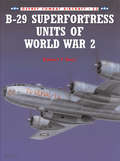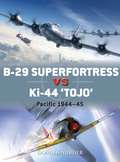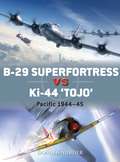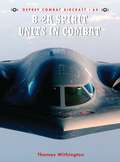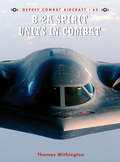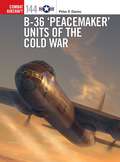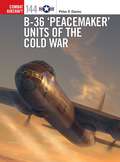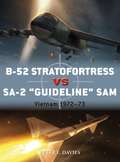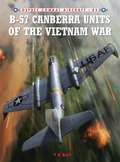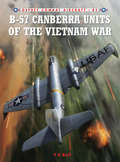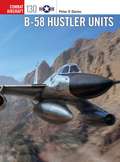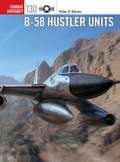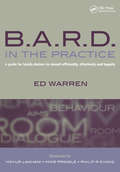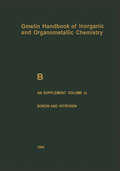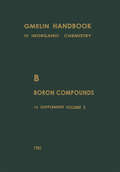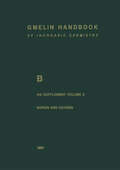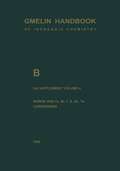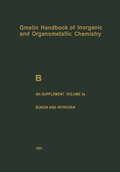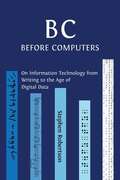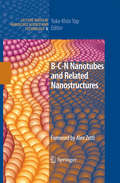- Table View
- List View
B-29 Superfortress Units of World War 2 (Combat Aircraft #33)
by Mark Styling Robert F DorrThe ultimate piston-engined heavy bomber of World War 2, the first production B-29s were delivered to the 58th Very Heavy Bomb Wing in the autumn of 1943. By the spring of 1944 the Superfortress was bombing targets in the Pacific, and by war's end the aircraft had played as great a part as any weapon in ending the conflict with the Japanese. Indeed, the final dropping of two atomic bombs from the B-29 convinced the Japanese to sue for peace. This book traces the wartime career of the B-29, as the aircraft went from strength to strength in the Pacific Theatre.
B-29 Superfortress vs Ki-44 "Tojo": Pacific Theater 1944–45 (Duel)
by Jim Laurier Gareth Hector Donald NijboerBy the time the Americans began their aerial bombardment of Japan in 1944, both the JAAF and IJNAF were spent forces. What the Japanese did have though was the Ki-44 "Tojo". Armed with two 40 mm cannon, it was the most heavily armed and feared single-seat fighter to see action against the new American bomber, the B-29 Superfortress. For the bomber crews, they had what they believed was their 'ace in hole': a fully armed B-29 carried four remotely operated gun turrets and a tail gunner's position, making it the world's most advanced self-defending bomber.In every respect the Ki-44 pilots were fighting a desperate battle. Many who made their mark did so using suicidal ramming attacks or "taiatari". Illustrated with full colour artwork, this volume examines why the Ki-44 was unable to break up bomber formations conventionally during the Pacific War, and how its ramming tactics, while terrifying, graphically revealed Japan's inability to stop the B-29.
B-29 Superfortress vs Ki-44 "Tojo": Pacific Theater 1944–45 (Duel #82)
by Jim Laurier Gareth Hector Donald NijboerBy the time the Americans began their aerial bombardment of Japan in 1944, both the JAAF and IJNAF were spent forces. What the Japanese did have though was the Ki-44 "Tojo". Armed with two 40 mm cannon, it was the most heavily armed and feared single-seat fighter to see action against the new American bomber, the B-29 Superfortress. For the bomber crews, they had what they believed was their 'ace in hole': a fully armed B-29 carried four remotely operated gun turrets and a tail gunner's position, making it the world's most advanced self-defending bomber.In every respect the Ki-44 pilots were fighting a desperate battle. Many who made their mark did so using suicidal ramming attacks or "taiatari". Illustrated with full colour artwork, this volume examines why the Ki-44 was unable to break up bomber formations conventionally during the Pacific War, and how its ramming tactics, while terrifying, graphically revealed Japan's inability to stop the B-29.
B-2A Spirit Units in Combat (Combat Aircraft)
by Chris Davey Thomas WithingtonThe B-2A 'Spirit' was an aircraft conceived to fight the Cold War but which has proved invaluable to both the 'New World Order' and more recently the 'War on Terrorism'. The combination of low-observability, precision strike, range and payload flexibility has made the 'Spirit' the weapon of choice when America hits its enemies at the start of a campaign. Spirits have fired the first shots of Operation 'Allied Force' over Kosovo and Serbia, as well as operations 'Enduring Freedom' and 'Iraqi Freedom'. Despite the tremendous cost of the aircraft – each unit is literally worth its weight in gold – the B-2 has had an impact on modern warfare which has vastly exceeded this small force of 21 bombers. Developed in utmost secrecy, the B-2's gestation saw the use of new computer design and manufacturing techniques and ultra-modern synthetic materials making it the most revolutionary aircraft in terms of design and performance. This book examines these incredible aircraft.
B-2A Spirit Units in Combat (Combat Aircraft #64)
by Chris Davey Thomas WithingtonThe B-2A 'Spirit' was an aircraft conceived to fight the Cold War but which has proved invaluable to both the 'New World Order' and more recently the 'War on Terrorism'. The combination of low-observability, precision strike, range and payload flexibility has made the 'Spirit' the weapon of choice when America hits its enemies at the start of a campaign. Spirits have fired the first shots of Operation 'Allied Force' over Kosovo and Serbia, as well as operations 'Enduring Freedom' and 'Iraqi Freedom'. Despite the tremendous cost of the aircraft – each unit is literally worth its weight in gold – the B-2 has had an impact on modern warfare which has vastly exceeded this small force of 21 bombers. Developed in utmost secrecy, the B-2's gestation saw the use of new computer design and manufacturing techniques and ultra-modern synthetic materials making it the most revolutionary aircraft in terms of design and performance. This book examines these incredible aircraft.
B-36 ‘Peacemaker’ Units of the Cold War (Combat Aircraft)
by Peter E. DaviesA fully illustrated study into the extraordinary Convair B-36 during the Cold War.Conceived during 1941 in case Germany occupied Britain, when US bombers would then have insufficient range to retaliate, the B-36 was to be primarily a '10,000-mile bomber' with heavy defensive armament, six engines and a performance that would prevent interception by fighters. Although rapid developments in jet engine and high-speed airframe technology quickly made it obsolescent, the B-36 took part in many important nuclear test programmes. The aircraft also provided the US nuclear deterrent until the faster B-52 became available in 1955. It was one of the first aircraft to use substantial amounts of magnesium in its structure, leading to the bomber's 'Magnesium Overcast' nickname. It earned many superlatives due to the size and complexity of its structure, which used 27 miles of wiring, had a wingspan longer than the Wright brothers' first flight, equivalent engine power to 400 cars, the same internal capacity as three five-room houses and 27,000 gallons of internal fuel – enough to propel a car around the world 18 times. Much was made of the fact that the wing was deep enough to allow engineers to enter it and maintain the engines in flight. B-36s continued in the bomber and reconnaissance role until their retirement in February 1959 following 11 years in SAC. Convair employees were invited to suggest names for the giant aircraft, eliciting suggestions such as 'King Kong Bomber', 'Condor', 'Texan' and 'Unbelievable', but the most popular was 'Peacemaker'. Oddly, objections from religious groups deterred the USAF from ever adopting it officially.This fully illustrated volume includes first-hand accounts, original photographs and up to 30 profile artworks depicting in detail the complexity of this superlative aircraft.
B-36 ‘Peacemaker’ Units of the Cold War (Combat Aircraft)
by Peter E. DaviesA fully illustrated study into the extraordinary Convair B-36 during the Cold War.Conceived during 1941 in case Germany occupied Britain, when US bombers would then have insufficient range to retaliate, the B-36 was to be primarily a '10,000-mile bomber' with heavy defensive armament, six engines and a performance that would prevent interception by fighters. Although rapid developments in jet engine and high-speed airframe technology quickly made it obsolescent, the B-36 took part in many important nuclear test programmes. The aircraft also provided the US nuclear deterrent until the faster B-52 became available in 1955. It was one of the first aircraft to use substantial amounts of magnesium in its structure, leading to the bomber's 'Magnesium Overcast' nickname. It earned many superlatives due to the size and complexity of its structure, which used 27 miles of wiring, had a wingspan longer than the Wright brothers' first flight, equivalent engine power to 400 cars, the same internal capacity as three five-room houses and 27,000 gallons of internal fuel – enough to propel a car around the world 18 times. Much was made of the fact that the wing was deep enough to allow engineers to enter it and maintain the engines in flight. B-36s continued in the bomber and reconnaissance role until their retirement in February 1959 following 11 years in SAC. Convair employees were invited to suggest names for the giant aircraft, eliciting suggestions such as 'King Kong Bomber', 'Condor', 'Texan' and 'Unbelievable', but the most popular was 'Peacemaker'. Oddly, objections from religious groups deterred the USAF from ever adopting it officially.This fully illustrated volume includes first-hand accounts, original photographs and up to 30 profile artworks depicting in detail the complexity of this superlative aircraft.
B-52 Stratofortress vs SA-2 "Guideline" SAM: Vietnam 1972–73 (Duel)
by Jim Laurier Gareth Hector Peter E. DaviesEver since its introduction in the late 1950s, the B-52 Stratofortress has been the United States' primary heavy bomber and a powerful symbol of its immense military might. Its powerful electronic countermeasures equipment (ECM) was thought to make the B-52 immune to ground-to-air missile attack, but in Vietnam, and later conflicts such as Operation Desert Storm in 1991, it came up against the Soviet-designed SA-2 SAM which used heavy salvoes of missiles to bring down the bombers.The losses of several of its most feared, powerful and supposedly invincible bombers per night to a torrent of Soviet missiles during the closing stages of the Vietnam War was sobering to Americans, but the B-52s' crushing attacks virtually eliminated North Vietnam's defences and forced a peace settlement. This fascinating book analyses the roles of the SA-2 operators and the B-52 Electronic Warfare Officers (EWOs) using specially commissioned artwork as well as first-hand accounts, and traces the cat-and-mouse tactics that each side employed.
B-52 Stratofortress Vs Sa-2 “Guideline” Sam Vietnam 1972–73: Vietnam 1972-73 (Duel Ser. #89)
by Peter E. DaviesEver since its introduction in the late 1950s, the B-52 Stratofortress has been the United States' primary heavy bomber and a powerful symbol of its immense military might. Its powerful electronic countermeasures equipment (ECM) was thought to make the B-52 immune to ground-to-air missile attack, but in Vietnam, and later conflicts such as Operation Desert Storm in 1991, it came up against the Soviet-designed SA-2 SAM which used heavy salvoes of missiles to bring down the bombers. The losses of several of its most feared, powerful and supposedly invincible bombers per night to a torrent of Soviet missiles during the closing stages of the Vietnam War was sobering to Americans, but the B-52s' crushing attacks virtually eliminated North Vietnam's defences and forced a peace settlement. This fascinating book analyses the roles of the SA-2 operators and the B-52 Electronic Warfare Officers (EWOs) using specially commissioned artwork as well as first-hand accounts, and traces the cat-and-mouse tactics that each side employed.
B-57 Canberra Units of the Vietnam War (Combat Aircraft)
by Jim Laurier T. E. BellThe B-57 Canberra was the first jet-powered American attack aircraft committed to the Vietnam War. Involved in day-to-day interdiction missions as well as in classified "black†? missions and a starring role in Operation Rolling Thunder; the B-57 evolved to become one of the most valuable weapons in the USAF inventory. The B-57E was involved in the Patricia Lynn missions, parts of which remain classified. This book also fully documents the role of the Australian Canberra B-20 in working alongside the B-57. Featuring scores of previously unpublished photographs; the story of the B-57 is the story of the Vietnam War.
B-57 Canberra Units of the Vietnam War (Combat Aircraft #85)
by Jim Laurier T. E. BellThe B-57 Canberra was the first jet-powered American attack aircraft committed to the Vietnam War. Involved in day-to-day interdiction missions as well as in classified "black†? missions and a starring role in Operation Rolling Thunder; the B-57 evolved to become one of the most valuable weapons in the USAF inventory. The B-57E was involved in the Patricia Lynn missions, parts of which remain classified. This book also fully documents the role of the Australian Canberra B-20 in working alongside the B-57. Featuring scores of previously unpublished photographs; the story of the B-57 is the story of the Vietnam War.
B-58 Hustler Units (Combat Aircraft)
by Peter E. DaviesOne of the most dramatic bombers of its day, the Convair B-58 came to epitomise the Cold War power of Strategic Air Command. Introduced only 12 years after the sound barrier was first broken, this iconic plane became the first large long-range supersonic bomber to take to the skies, a feat which had seemed far-fetched only a few years previously. Outstripping its contemporaries in terms of speed, and agile enough to escape most interceptors, the B-58 was a remarkable feat of engineering, setting 19 world speed records and collecting a host of trophies. The first operational bomber capable of Mach 2 at 63,000 feet, it was able to evade hostile fighters and represented a serious threat to targets across the Soviet Bloc. Supported by contemporary first-hand accounts, photography, and full-colour illustrations, this study explores the history of this ground-breaking aircraft from its conception to its little-known testing for use in the Vietnam War.
B-58 Hustler Units (Combat Aircraft #130)
by Peter E. DaviesOne of the most dramatic bombers of its day, the Convair B-58 came to epitomise the Cold War power of Strategic Air Command. Introduced only 12 years after the sound barrier was first broken, this iconic plane became the first large long-range supersonic bomber to take to the skies, a feat which had seemed far-fetched only a few years previously. Outstripping its contemporaries in terms of speed, and agile enough to escape most interceptors, the B-58 was a remarkable feat of engineering, setting 19 world speed records and collecting a host of trophies. The first operational bomber capable of Mach 2 at 63,000 feet, it was able to evade hostile fighters and represented a serious threat to targets across the Soviet Bloc. Supported by contemporary first-hand accounts, photography, and full-colour illustrations, this study explores the history of this ground-breaking aircraft from its conception to its little-known testing for use in the Vietnam War.
B.A.R.D. in the Practice: A Guide for Family Doctors to Consult Efficiently, Effectively and Happily
by Ed WarrenForewords by Mayur Lakhani, Mike Pringle and Philip R Evans Respectively Chairman of Communications and Publishing, Royal College of General Practitioners, London; Head of School and Professor of General Practice, University of Nottingham; Former President of WONCA Region Europe. This groundbreaking book describes a completely new approach to the medical consultation, focusing on four key points: Behaviour, Aims, Room and Dialogue (B.A.R.D.). This practical approach has gained support from the Royal College of General Practitioners and reflects the way real family doctors consult in the real world, to the benefit of both the practitioner and the patient. Practical suggestions are made throughout the guide, with training exercises to aid in application. B.A.R.D in the Practice provides important reading for all general practitioners and general practitioner registrars.
B.A.R.D. in the Practice: A Guide for Family Doctors to Consult Efficiently, Effectively and Happily
by Ed WarrenForewords by Mayur Lakhani, Mike Pringle and Philip R Evans Respectively Chairman of Communications and Publishing, Royal College of General Practitioners, London; Head of School and Professor of General Practice, University of Nottingham; Former President of WONCA Region Europe. This groundbreaking book describes a completely new approach to the medical consultation, focusing on four key points: Behaviour, Aims, Room and Dialogue (B.A.R.D.). This practical approach has gained support from the Royal College of General Practitioners and reflects the way real family doctors consult in the real world, to the benefit of both the practitioner and the patient. Practical suggestions are made throughout the guide, with training exercises to aid in application. B.A.R.D in the Practice provides important reading for all general practitioners and general practitioner registrars.
B & B Know-How: How to make money from your spare room
by Amy WillcockNo one knows more about starting and running a bed and breakfast business than successful cook, author and hotel owner Amy Willcock. The hotel that she runs with her husband and their business partner, The George on the Isle of Wight, was described in the Daily Mail as being run 'in the way in which you imagine the hotel of your dreams to be run'. In this attractively packaged paperback, Amy reveals the secrets you need to know to make running your B&B fun and profitable. Her lively narrative takes you through all stages of the process: preparing your home, advertising, creating welcoming bedrooms and luxury bathrooms on a budget, laundering the sheets, preparing the ultimate breakfast (for even the most demanding guest) and managing bookings - all this, while keeping your profit margin healthy. Also featured are the best stockists for any products that you will need and the definitive answers to frequently asked questions. This book is the perfect guide for all aspiring B&B landlords and ladies.
B Boron Compounds: Boron and Noble Gases, Hydrogen (Gmelin Handbook of Inorganic and Organometallic Chemistry - 8th edition #B / 1-20 / 1-4 / 4 / 1 / a)
by Lawrence Barton Thomas OnakA broad coverage of boron topics is provided. Structural elucidations and convenient routes to useful hydroboration reagents are presented as well as boron compounds used for medical purposes. Special attention is devoted to theoretical studies and calculations on small boron-hydrogen and boron-noble gas species including molecules like BH, which are rather favorite subjects of theoreticians for testing various methods of calculation.
B Boron Compounds: Boron and Chalcogens. Carboranes. Formula Index for 1st Suppl. Vol. 1 to 3 (Gmelin Handbook of Inorganic and Organometallic Chemistry - 8th edition #B / 1-20 / 1-4 / 1 / 3)
by Karl Beeker Thomas OnakB Boron Compounds: 3rd Supplement Volume 2 Boron and Oxygen (Gmelin Handbook of Inorganic and Organometallic Chemistry - 8th edition #B / 1-20 / 1-4 / 3 / 2)
by Gert HellerThe 3rd supplement continues the updating of the original 20 volumes on boron com pounds published between 1974 and 1979. The first supplement to this series brought the literature closing date uniformly to the end of 1977, whereas the two volumes of the 2nd supplement have extended the literature coverage of boron compounds to 1980. Selection and presentation of data parallel the style selected for the two previous supplement volumes, which appeared in 1980/1 and 1982/3, respectively. The Gmelin Principle of the Last Position is largely adhered to, excepting substituted polyboron species containing boron-boron bonds (all of which are found in Chapter 2 within the system boron-hydrogen). Examples of organic derivatives are included, especially in those cases where the carbon-free species are not known; and the carboranes are treated comprehensively. The literature is considered through 1984. Part 1 of the present 3rd supplement contains the systems boron-noble gases and boron hydrogen; Part 2 contains the system boron-oxygen. Part 3 will contain the systems boron nitrogen, boron-fluorine, and boron-chlorine; the remaining systems and a formula indexwill be included in the final 4th part of this supplement. The first chapter of the present volume on the compounds of boron and oxygen provides sections on the binary boron oxides, including some radicals, and the anhydrous berate ions. The following chapter describes boron-oxygen compounds with hydrogen or organyl groups.
B Boron Compounds: Boron and Cl, Br, I, S, Se, Te, Carboranes (Gmelin Handbook of Inorganic and Organometallic Chemistry - 8th edition #B / 1-20 / 1-4 / 3 / 4)
by Gert Heller Anton Meller Thomas OnakThe 3rd supplement continues the updating of the original 20 volumes on boron compounds published between 1974 and 1979. The first supplement consisting of 3 volumes covered all the literature uniformly up to the end of 1977, whereas the two volumes of the 2nd supplement have extended the literature coverage of boron compounds to 1980 and the four volumes of the 3rd supplement to 1984. The present volume continues the description of boron compounds with halogens, presenting those with chlorine, bromine and iodine. The compounds with chalcogens are completed here along with those of boron with S, Se, Te and Po. The final chapter on carboranes contains the carboranes themselves, together with metallacarboranes, and in the last section a description of carborane-containing polymers, mostly derived from the three isomeric dicarbadodecarboranes. Volume 4 of the 3rd supplement brings this supplement series to an end. It will be supplemented by a separately appearing index volume, which contains all the boron compounds dealt with in volumes 1 - 4 of this supplement series.
B Boron Compounds: 4th Supplement, Boron and Nitrogen (Gmelin Handbook of Inorganic and Organometallic Chemistry - 8th edition #B / 1-20 / 1-4 / 4 / 3 / a)
by Anton MellerThe present issue, Volume 3a of "Boron Compounds" 4th Supplement of the Gmelin Hand book, presents the description of boron nitride and a part of other boron compounds containing nitrogen. Volume 3 b (to be published Later) will complete the presentation of the boron-nitrogen compounds and will also cover boron compounds containing fluorine. Due to technical circumstances, Volume 1 (systems with hydrogen) and Volume 2 (systems with oxygen) of this particular supplement will be published subsequently, whereas Volume 4 (boron compounds containing CL, Br, I, S, Se, and Te, as well as a section containing carboranes) has already been published. ALL volumes of the 4th Supplement will be augmented by a formula index. The IUPAC nomenclature is generally adhered to; occasional abbreviations for compounds are explained in the text. A positive sign for the chemical shifts of the NMR signals indicates a 1 13 downfield shift from the references, usually internal (CH ) Si for 6 H and 6 C and external 3 4 11 (C H h0-BF for 6 B, others being specified. 2 5 3 In contrast to more recent publications but remaining consistent with the previous volumes of the Boron Series, the iminoborane structure is written as B=N and not as B=N. In fact, the real electronic structure is more realistically symbolized by B=N, but it seems reasonable to avoid =NR in accordance with the commonly accepted "iminoborane" nomenclature.
B C, Before Computers: On Information Technology From Writing To The Age Of Digital Data
by Stephen RobertsonB C, Before Computers: On Information Technology From Writing To The Age Of Digital Data
by Stephen RobertsonThe idea that the digital age has revolutionized our day-to-day experience of the world is nothing new, and has been amply recognized by cultural historians. In contrast, Stephen Robertson's BC: Before Computers is a work which questions the idea that the mid-twentieth century saw a single moment of rupture. It is about all the things that we had to learn, invent, and understand - all the ways we had to evolve our thinking - before we could enter the information technology revolution of the second half of the twentieth century. Its focus ranges from the beginnings of data processing, right back to such originary forms of human technology as the development of writing systems, gathering a whole history of revolutionary moments in the development of information technologies into a single, although not linear narrative. <p><p> Treading the line between philosophy and technical history, Robertson draws on his extensive technical knowledge to produce a text which is both thought-provoking and accessible to a wide range of readers. The book is wide in scope, exploring the development of technologies in such diverse areas as cryptography, visual art and music, and the postal system. Through all this, it does not simply aim to tell the story of computer developments but to show that those developments rely on a long history of humans creating technologies for increasingly sophisticated methods of manipulating information. <p> Through a clear structure and engaging style, it brings together a wealth of informative and conceptual explorations into the history of human technologies, and avoids assumptions about any prior knowledge on the part of the reader. As such, it has the potential to be of interest to the expert and the general reader alike.
B C, Before Computers: On Information Technology From Writing To The Age Of Digital Data
by Stephen RobertsonB-C-N Nanotubes and Related Nanostructures (Lecture Notes in Nanoscale Science and Technology #6)
by Yoke Khin YapCarbon nanotubes (CNTs) and Boron nitride nanotubes (BNNTs) are part of the so-called B-C-N material system, which includes novel nanostructures of carbon (C), doped-carbon, boron (B), boron nitride (BN), carbon nitride (CNx), boron-carbon nitride (BxCyNz), and boron carbide (BxCy). BNNTs and CNTs are structurally similar and share extraordinary mechanical properties, but they differ in chemical, biological, optical, and electrical properties. Therefore, hybrid nanotubes constructed of B, C, N elements are expected to form a new class of nanotubes with tunable properties between those of CNTs and BNNTs. In addition, these B-C-N nanostructures will further enhance and complement the applications of CNTs and BNNTs. With contributions from leading experts, B-C-N Nanotubes and Related Nanostructures is the first book to cover all theoretical and experimental aspects of this emerging material system, and meets the need for a comprehensive summary of the tremendous advances in research on B-C-N materials in recent years.
